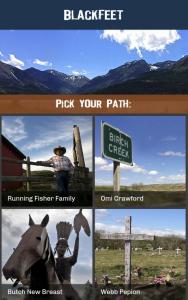By Staff Reports
(Oahu)– Montana suffered its worst natural disaster in June of 1964, when two dams collapsed and flooded Two Medicine River, killing 29 people and destroying the homes of hundreds of others. Media coverage at the time was extensive, and earned the state its first Pulitzer Prize, to The Hungry Horse News, but it also, in retrospect, had a major hole in it. The people most affected by the tragedy, the Blackfeet tribal members, were difficult to reach in the aftermath, and their stories were left untold for decades.
Last year, to commemorate the 50th anniversary of the flood, a research team of independent journalists and scholars from UH Mānoa, Washington State University and the University of Oregon joined forces and interviewed more than 20 witnesses, both survivors and rescuers. Those interviews were converted into journalistic videos, and then shared via a prototype mobile app during the ceremonies. Through feedback and use, this free Blackfeet ’64 Flood app has been redesigned and reprogrammed during the past six months for a broader public audience, and was released this month to the masses through both the Apple and Android markets.
The app development and distribution portion of the project was led by Brett Oppegaard, an assistant professor at UH Mānoa in the School of Communications, College of Social Sciences. He studies mobile technologies and ubiquitous computing.
“The stories of the Blackfeet were lost to time, and in danger of disappearing altogether,” Oppegaard said. “Our team’s first priority was to document these stories and tell the bigger narrative of the ’64 flood more fully, through the perspectives of the people who actually lost their lives, family members and homes. My hope for the mobile portion of this project was to also reopen the discussion of the flood for contemporary participation. I wanted this to be a story about today, too, not just a historical piece.”
In turn, users of the app can watch the flood-related videos – created by award-winning journalists and filmmakers – and witness the disaster’s effects on the Blackfeet population. In addition, they also can directly comment on those videos in many media forms, including text, audio and video, and share those thoughts via their social media channels. Discussion prompts accompany each video in this app, and the sharing options match the social media apps on each individual’s smartphone. Both tribal and non-tribal members are encouraged to offer reflections and interpretations.
The videos in the app were produced by Benjamin Shors, a clinical assistant professor at The Edward R. Murrow College of Communication at Washington State University; David Grewe, a WSU clinical assistant professor of communication; Torsten Kjellstrand, a visiting assistant professor at the University of Oregon; Blackfeet journalist Lailani Upham; and Blackfeet/Salish filmmaker Brooke Swaney. Oppegaard served as mobile media director, leading the development and design team.
Oppegaard was the individual recipient of the regional and national 2012 George and Helen Hartzog Award for his research into mobile app development and media delivery systems within the National Park Service as well as the national 2013 John Wesley Powell Prize winner for outstanding achievement in the field of historical displays. He also teaches communication and digital media classes stemming from his many years of experience working for daily newspapers, during which he earned several national, regional and state awards. He was chosen for a National Endowment for the Arts fellowship as a journalist and also has earned National Endowment for the Humanities’ grants as a scholar for his innovative mobile media research projects.
This ’64 Flood project has been funded by grants from both Humanities Montana and Vision Maker Media.
For more information about this project, visit http://sixtyfourflood.com.
To download the app:
For Android devices, visit https://play.google.com/store/apps/details?id=org.radiojoe.blackfeet.
For Apple devices, visit https://itunes.apple.com/us/app/blackfeet-1964/id884379899?mt=8.
The School of Communications in the College of Social Sciences at the University of Hawai‘i at Mānoa offers academic programs in Communication and Journalism. Communication focuses on communication in intercultural and professional communities, information and communication technologies (ICTs) and policy, and the media arts. Journalism is professionally oriented and develops critical thinking skills and ability to gather, analyze, and organize information, and to communicate it clearly and responsibly through print, broadcast, and online media.
The College of Social Sciences (CSS) at the University of Hawai‘i at Mānoa is engaged in a broad range of research endeavors that address fundamental questions about human behavior and the workings of local, national and international political, social, economic and cultural institutions. Its vibrant student-centered academic climate supports outstanding scholarship through internships, and active and service learning approaches to teaching that prepare students for the life-long pursuit of knowledge.

